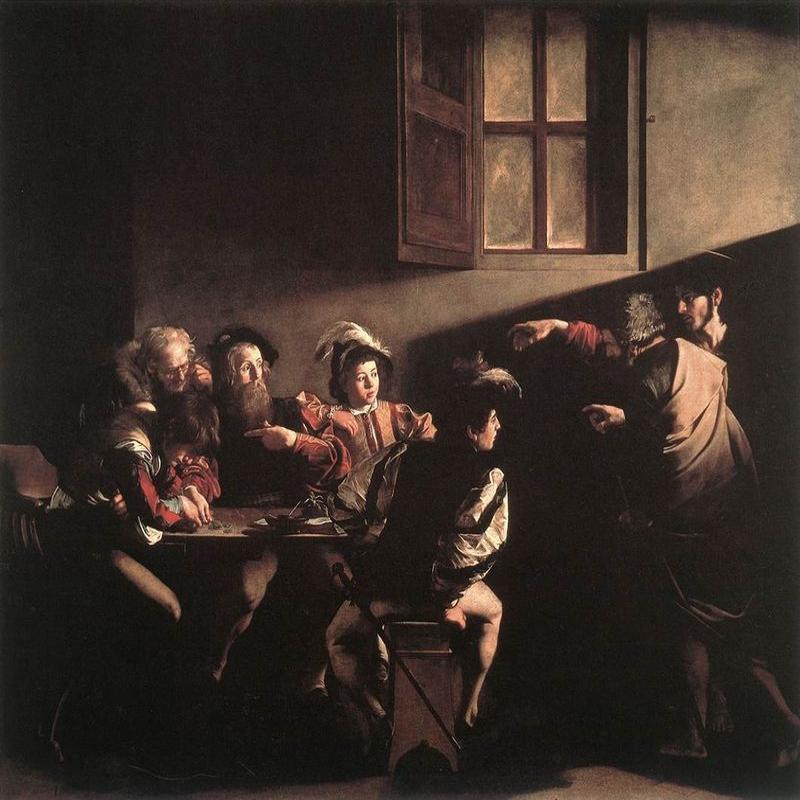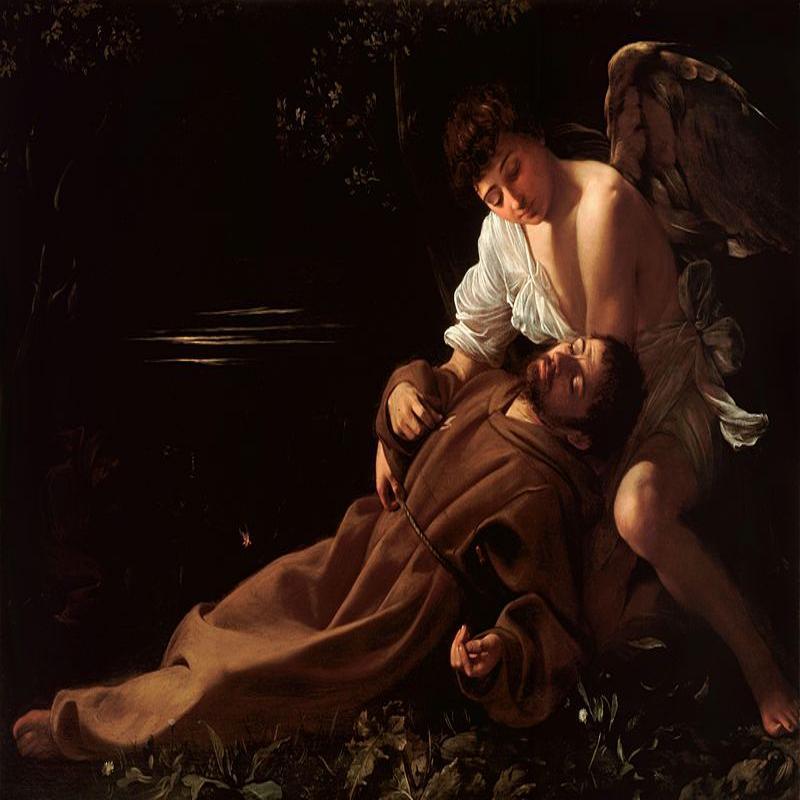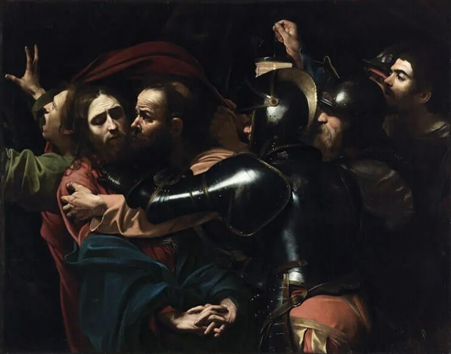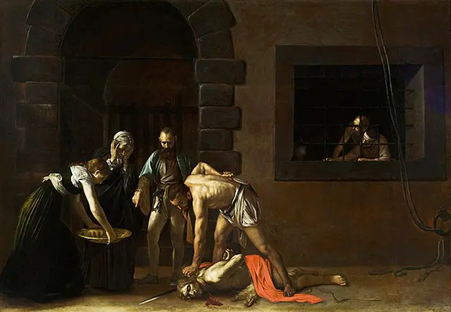Caravaggio: The Artist as a Doomed Man
Posted on 4th February 2021
Caravaggio was a commissioned artist who depicted the standard religious iconography of his day yet he was to turn that standard on its head for his subject matter was always secondary to the emotional outpourings of a man beset by demons; and painting with a passion that tore at the very fabric of the material of his imaginings he committed self-mortification as exoneration from a life set upon the path of self-destruction the sins of which he could not confess with any sincerity.
Michelangelo Merisi was born in Milan on 29 September 1571, but raised in the town of Caravaggio in Lombardy from which he derived his name. His family were prosperous and well-connected and were to remain so despite the death of both his mother and father before he reached the age of 14, by which time he was already serving a four-year apprenticeship in the studio of the artist Simone Peterzano in Milan.

Working to strict guidelines and copying the work of other artists was something that bored him but his frustration aside he was delighted to be in Milan away from the siblings he disliked intensely and the anger he felt toward his dead parents for making him an orphan.
In Milan he became fascinated by street life particularly its darker, seamier side where often intoxicated he would indulge his passions both physical and emotional with a violence that would inevitably lead to trouble. When in the summer of 1592, an altercation led to him being arrested for injuring a Law Officer he fled Milan for Rome rather than remain and face an often-arbitrary justice.
Rome with its great wealth and grinding poverty, its many taverns and brothels, its pickpockets and charlatans, its splendour and its piety provided opportunities much more to the liking of a struggling but ambitious artist. It was said that Caravaggio arrived in Rome ‘naked and needy’ but he soon found employment as a studio hack turning out works of dull orthodoxy barely worthy of his talents - a view he wasn’t shy in expressing. His barber provides us with an early description of the youthful, swaggering, self-confident Caravaggio: "This painter is a stocky young man with a sparse black beard, bushy eyebrows, and dark eyes. He wears black clothes which are a bit shabby and wears his hair loose and long at the front."

His talent was difficult to ignore however, and it wasn’t long before he was discovered by Cardinal Francisco Maria Del Monte, a close friend of Pope Clement and an enthusiastic patron of the arts who had been impressed by several Caravaggio’s early works such as The Fortune Teller and The Card Sharps which had proved hugely popular.
The religious art of the Catholic Church which had long been used not only to beautify the faith but overwhelm the people with its majesty was also at the forefront of the propaganda war against the Protestant Reformation, and Caravaggio was to become its greatest exponent. No one else it seemed could quite provide the dirt under the fingernails or make the blood so real and the martyrdom so pained as Caravaggio - the redemption sought never so yearned for as by the man who sinned for its own sake.
Discarding convention, he painted with the power of the eye refusing to distort the truth to create idealised images to placate the desire of his patrons, an approach that was to see many of his commissions returned for re-touching or simply returned and unpaid for. His painting The Groom’s Madonna that had been commissioned to hang in St Peter’s was removed after just two days following complaints with a Vatican secretary writing: In this painting there is but vulgarity, sacrilege, impiety, and disgust. One would say it is the work of a painter who could paint well but is of a dark spirit who has been for a long time far from God.
But his paintings spoke a truth, the truth as he knew and experienced it, and his methods were as unconventional as his lifestyle. He rarely took time to prepare, he did no preliminary drawings, and his models were the street waifs, the whores, the crooks and the gamblers that infested the alleyways and taverns he knew so well. Paintings such as The Martyrdom of St Matthew and The Crucifixion of St Peter brought the brutal reality of the gutter to the artist’s garret even if some thought them vulgar and irreligious to the point of blasphemy. Regardless of the criticism Caravaggio was fast becoming the most famous painter in Rome and he revelled in it. Floris Claes van Dijk, a contemporary of Caravaggio’s described him at the time: After a fortnights work he will swagger about for a month or two with a sword at his side and a servant following him, from one ball-court to the next, ever ready for a fight or an argument, so it is most awkward to get along with him.
Being the friend of Cardinals and men of influence had done little to moderate his behaviour in fact it made it worse believing he now had a status worthy of respect and could act with impunity as a result. So along with his gang of thugs he would roam the streets of the city at night intimidating those they met, roughing up others and engaging in fights - violence being a traditional rite of passage for the young bloods of Rome; when a waiter at the Taverna del Moro who brought him a dozen artichokes, half soaked in butter and half in olive oil answered his question as to which was which with a dismissive, "Why don't you smell them and find out," he exploded in anger throwing the plate at the him, overturning the table, and drawing his sword threatening to cut him; in 1605, sued by his landlady for six months unpaid rent he responded by throwing stones at her window and calling her out as a whore.
When one of his competitors, the artist Giovanni Baglione (who Caravaggio contemptuously referred to as Johnny Baggage) was commissioned to paint the altarpiece, the Resurrection of Jesus, for the II Gesu, or Church of the Jesuits in Rome a jealous Caravaggio mocked his work in public, bad-mouthed him in taverns and posted scurrilous verses about him around the city. Baglione sued him for libel and despite Caravaggio refusing to apologise saying "I don't know anyone who thinks Baglione is a good artist" he was found guilty, fined, and imprisoned for six weeks.
Released from confinement on the promise of good behaviour he carried on much as before and strings continued to be pulled to extricate him from one difficulty or another, but he overstepped the mark when on 29 May 1606, in a fight over a woman he killed a local street thug, Ranuccio Tomassoni. Now wanted for murder and with a warrant issued for his arrest he became subject to a Banda Capitale which permitted any citizen of the Papal States to kill him and deliver his head to receive the reward that had been posted. But it wasn't just the law he now had to fear but the Tomassoni Clan who sought a death for a death.
There were now little his friends could do for him and he fled Rome for Naples where his connection to the powerful Colonna family (his father had previously worked for them) would at least protect him from prosecution but hey could do little to protect him from harm in a city crawling with cutthroats and assassins for hire.
Naples was delighted to have procured Rome’s most celebrated artist and the commissions rolled in but despite producing some of his best work Caravaggio was scared and feared for his life, and with good reason. He chose not to remain long and after six months in Naples he left for Malta perhaps believing that the sea would provide greater security.
Still the famous artist he was once again feted even being initiated into the Knights of Malta, but his newly elevated status did little to improve his character and arrested for assaulting another knight he was briefly imprisoned before engineering his own escape and taking ship for Sicily.
His reputation as both a celebrated artist and a madman went before him but the Sicilians were willing to embrace the former while turning a blind eye to the latter and for a time he was free to work and did so furiously his paintings becoming ever darker in both theme and brushstroke, as if he were a man on borrowed time - he slept fully clothed, his sword at his side or beneath his pillow, for in offending the Knights of Malta and evading justice yet again he had made another dangerous enemy.
In October 1609, he returned to Naples but not long after his return just as he had feared he was attacked by a gang of assassins in the notorious Cerriglio Tavern and so badly beaten that he was not only facially disfigured but was reported to have been killed. Now desperate to return to Rome he contacted influential friends to beg Pope Paul V on his behalf to exonerate him of his crimes. He would even be willing to pay recompense to the family of his victim.

Meanwhile, in acts of apparent contrition he painted Salome with the Head of John the Baptist and David with the Head of Goliath - the severed head in both cases being drawn in his own image.
By the summer of 1610, believing a pardon was imminent he set-off for Rome with the paintings he intended to distribute as gifts - but it wasn’t to be. On the journey north the ship taking him to Rome stopped off at the port of Palo where going ashore Caravaggio was arrested in a case of mistaken identity. He no doubt would have been released in time but instead decided to bribe his way out of prison only to discover the ship had gone on without him. In was in a state of some distress that he set off in pursuit.
Weak with hunger and suffering from a fever Caravaggio had walked miles along beaches and across clifftops in pursuit of a ship on the horizon he believed was his. On 18 July, suffering from a fever Caravaggio was found slumped on the beach at Porto Ercole in Tuscany. Taken to a nearby hospice he died soon after, aged 38.
At least so it was reported, but it was just as possible his enemies of which he had a great many had at last caught up with him.

The Calling of St Matthew

Judith Beheading Holofernes

David with the Head of Goliath

Saint Francis of Assisi in Ecstasy

Supper with Emmaus

The Martyrdom of St Peter

St Jerome Writing

The Musicians

Bacchus

The Taking of Christ

The Beheading of Saint John the Baptist

St Catherine of Alexandria
Tagged as: Ancient & Medieval, Art
Share this post:





